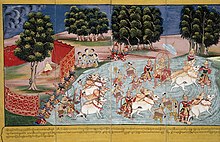
Narrative images of episodes from the life of Gautama Buddha in art have been intermittently an important part of Buddhist art, often grouped into cycles, sometimes rather large ones. However, at many times and places, images of the Buddha in art have been very largely single devotional images without narrative content from his life on Earth.
The literary accounts of the life of Gautama Buddha vary considerably in details but are mostly consistent in describing the main events.[1] One of the largest surviving bodies of artistic depictions is the rather small stone reliefs of Gandharan art, beginning in the 1st century BC and continuing for several centuries. These reliefs probably reflected subjects in paintings, both murals and illustrating manuscripts, none of which survive.[2] Their range of about 50 subjects is large,[3] and very rarely exceeded in later art, except in the 120 large reliefs at Borobudor in Java, Indonesia, (but 27 of these are of subjects before his birth); in East Asian Buddhism some new biographical subjects appeared much later, but otherwise the Gandharan subjects include the great majority of scenes appearing later.[4]


The 9th-century Borobudor reliefs illustrate the Lalitavistara Sūtra,[5] a Mahayana text, originally in Sanskrit, probably from the 3rd century. This only covers the life up to the Buddha's first Sermon. There is also a large body of Jataka tales, relating events from the many previous lives of Gautama Buddha, which were often subjects in Gandhara and early Indian art. By contrast, narrative scenes from the history of Buddhism after the Buddha's death are very few.[6]

In post-Gupta India a number of the most important scenes were grouped together; again stone reliefs on steles have survived, but painted versions only from later periods, and mostly from other countries. The most important grouping was The Eight Great Events in the Life of Buddha.[7] In Tibetan Buddhism ten or twelve scenes were more common in painted thankas, the twelve being the "twelve actions (or deeds) of the Buddha".[8] There are much larger numbers of painted scenes surviving from more recent centuries, especially from South-East Asia. With the arrival of printing, book illustrations and posters continued the tradition. Some scenes became established subjects in Chinese and Japanese painting, and later prints.
